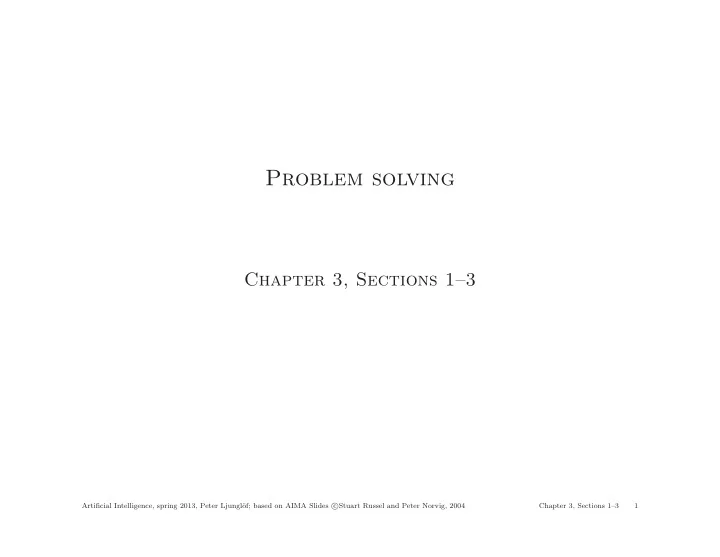

Problem solving Chapter 3, Sections 1–3 of; based on AIMA Slides c Artificial Intelligence, spring 2013, Peter Ljungl¨ � Stuart Russel and Peter Norvig, 2004 Chapter 3, Sections 1–3 1
Problem types Deterministic, fully observable = ⇒ single-state problem Agent knows exactly which state it will be in; solution is a sequence Non-observable = ⇒ conformant problem Agent may have no idea where it is; solution (if any) is a sequence Nondeterministic and/or partially observable = ⇒ contingency problem percepts provide new information about current state solution is a contingent plan or a policy often interleave search, execution Unknown state space = ⇒ exploration problem (“online”) of; based on AIMA Slides c Artificial Intelligence, spring 2013, Peter Ljungl¨ � Stuart Russel and Peter Norvig, 2004 Chapter 3, Sections 1–3 2
Example: Romania We are on holiday in Romania; currently in Arad Our flight leaves tomorrow from Bucharest Formulate goal: be in Bucharest Formulate problem: states: various cities actions: drive between cities Find solution: sequence of cities, e.g., Arad, Sibiu, Fagaras, Bucharest Problem type: deterministic, fully observable = ⇒ single-state problem of; based on AIMA Slides c Artificial Intelligence, spring 2013, Peter Ljungl¨ � Stuart Russel and Peter Norvig, 2004 Chapter 3, Sections 1–3 3
Example: Romania Oradea 71 Neamt 87 Zerind 151 75 Iasi Arad 140 92 Sibiu Fagaras 99 118 Vaslui 80 Rimnicu Vilcea Timisoara 142 211 111 Pitesti Lugoj 97 70 98 Hirsova 85 146 101 Mehadia Urziceni 86 75 138 Bucharest 120 Dobreta 90 Craiova Eforie Giurgiu of; based on AIMA Slides c Artificial Intelligence, spring 2013, Peter Ljungl¨ � Stuart Russel and Peter Norvig, 2004 Chapter 3, Sections 1–3 4
Single-state problem formulation A problem is defined by five components: initial state, e.g., In ( Arad ) actions Actions ( s ) = set of actions for state s e.g., Actions ( In ( Arad )) = { Go ( Sibiu ) , Go ( Timisoara ) , Go ( Zerind ) } transitions Result ( s, a ) = the successor state e.g., Result ( In ( Arad ) , Go ( Zerind )) = In ( Zerind ) goal test, can be an explicit set of states, e.g., { In ( Bucharest ) } or an implicit property, e.g., checkmate in chess path cost is the sum of the step costs c ( s, a, s ′ ) e.g., sum of distances, number of actions executed, etc. in this chapter we assume c to be positive A solution is a sequence of actions leading from the initial state to a goal state of; based on AIMA Slides c Artificial Intelligence, spring 2013, Peter Ljungl¨ � Stuart Russel and Peter Norvig, 2004 Chapter 3, Sections 1–3 5
Selecting a state space Real world is absurdly complex ⇒ state space must be abstracted for problem solving (Abstract) state = set of real states (Abstract) action = complex combination of real actions e.g., Result ( In ( Arad ) , Go ( Zerind )) represents a complex set of possible routes, detours, rest stops, etc. (Abstract) solution = set of real paths that are solutions in the real world Each abstract action should be “easier” than the original problem! of; based on AIMA Slides c Artificial Intelligence, spring 2013, Peter Ljungl¨ � Stuart Russel and Peter Norvig, 2004 Chapter 3, Sections 1–3 6
Example: vacuum world state space graph R L R L S S R R L R L R L L S S S S R L R L S S states??: integer dirt and robot locations (ignore dirt amounts etc.) initial state??: any state actions??: Left , Right , Suck , NoOp goal test??: no dirt in any location path cost??: 1 per action (0 for NoOp ) of; based on AIMA Slides c Artificial Intelligence, spring 2013, Peter Ljungl¨ � Stuart Russel and Peter Norvig, 2004 Chapter 3, Sections 1–3 7
Example: The 8-puzzle states??: a 3 × 3 matrix of integers 0 ≤ n ≤ 8 initial state??: any state actions??: move the blank space: left, right, up, down goal test??: equal to goal state (given above) path cost??: 1 per move of; based on AIMA Slides c Artificial Intelligence, spring 2013, Peter Ljungl¨ � Stuart Russel and Peter Norvig, 2004 Chapter 3, Sections 1–3 8
Example: The 8-queens problem states??: any arrangement of 0 to 8 queens on the board initial state??: no queens on the board actions??: add a queen to any empty square goal test??: 8 queens on the board, none attacked path cost??: 1 per move Using this formulation, there are 64 · 63 · · · · 57 ≈ 1 . 8 × 10 14 possible sequences to explore! of; based on AIMA Slides c Artificial Intelligence, spring 2013, Peter Ljungl¨ � Stuart Russel and Peter Norvig, 2004 Chapter 3, Sections 1–3 9
Example: The 8-queens problem (alternative) states??: one queen per column in the leftmost columns, none attacked initial state??: no queens on the board actions??: add a queen to any square in the leftmost empty column, making sure that no queen is attacked goal test??: 8 queens on the board, none attacked path cost??: 1 per move Using this formulation, we have only 2,057 sequences! of; based on AIMA Slides c Artificial Intelligence, spring 2013, Peter Ljungl¨ � Stuart Russel and Peter Norvig, 2004 Chapter 3, Sections 1–3 10
Example: robotic assembly P R R R R R states??: real-valued coordinates of robot joint angles parts of the object to be assembled actions??: continuous motions of robot joints goal test??: complete assembly of the object path cost??: time to execute of; based on AIMA Slides c Artificial Intelligence, spring 2013, Peter Ljungl¨ � Stuart Russel and Peter Norvig, 2004 Chapter 3, Sections 1–3 11
Recommend
More recommend